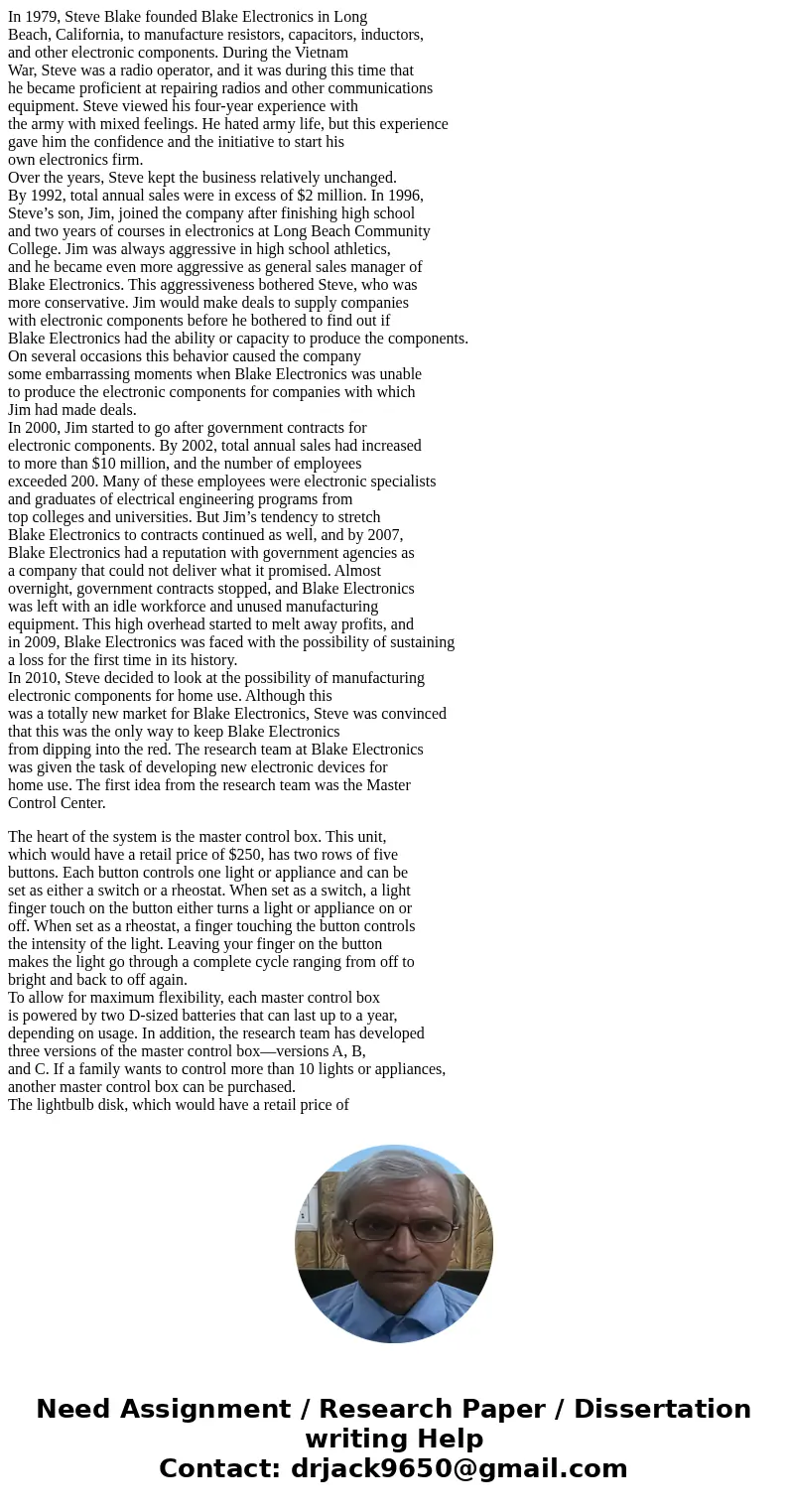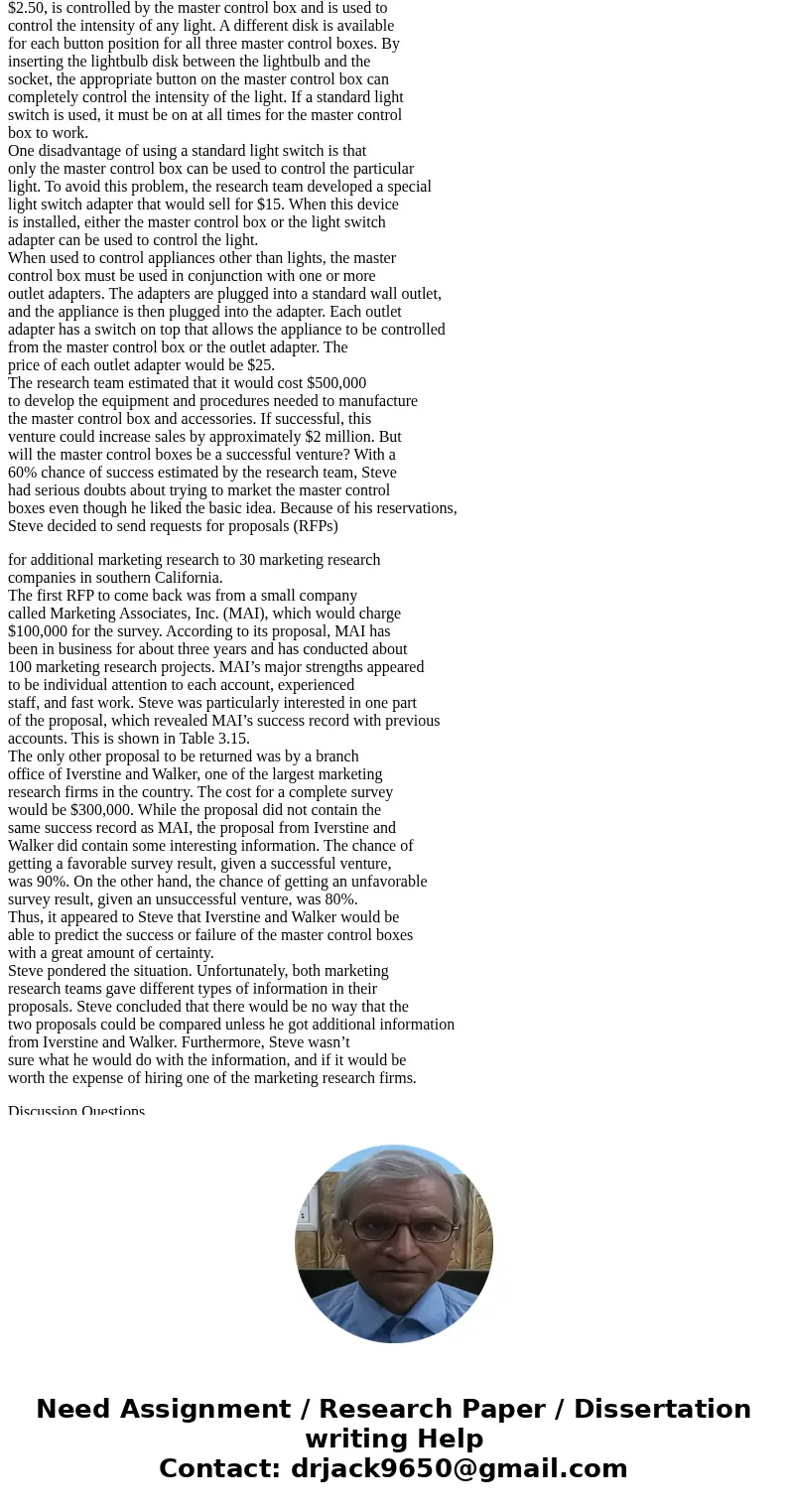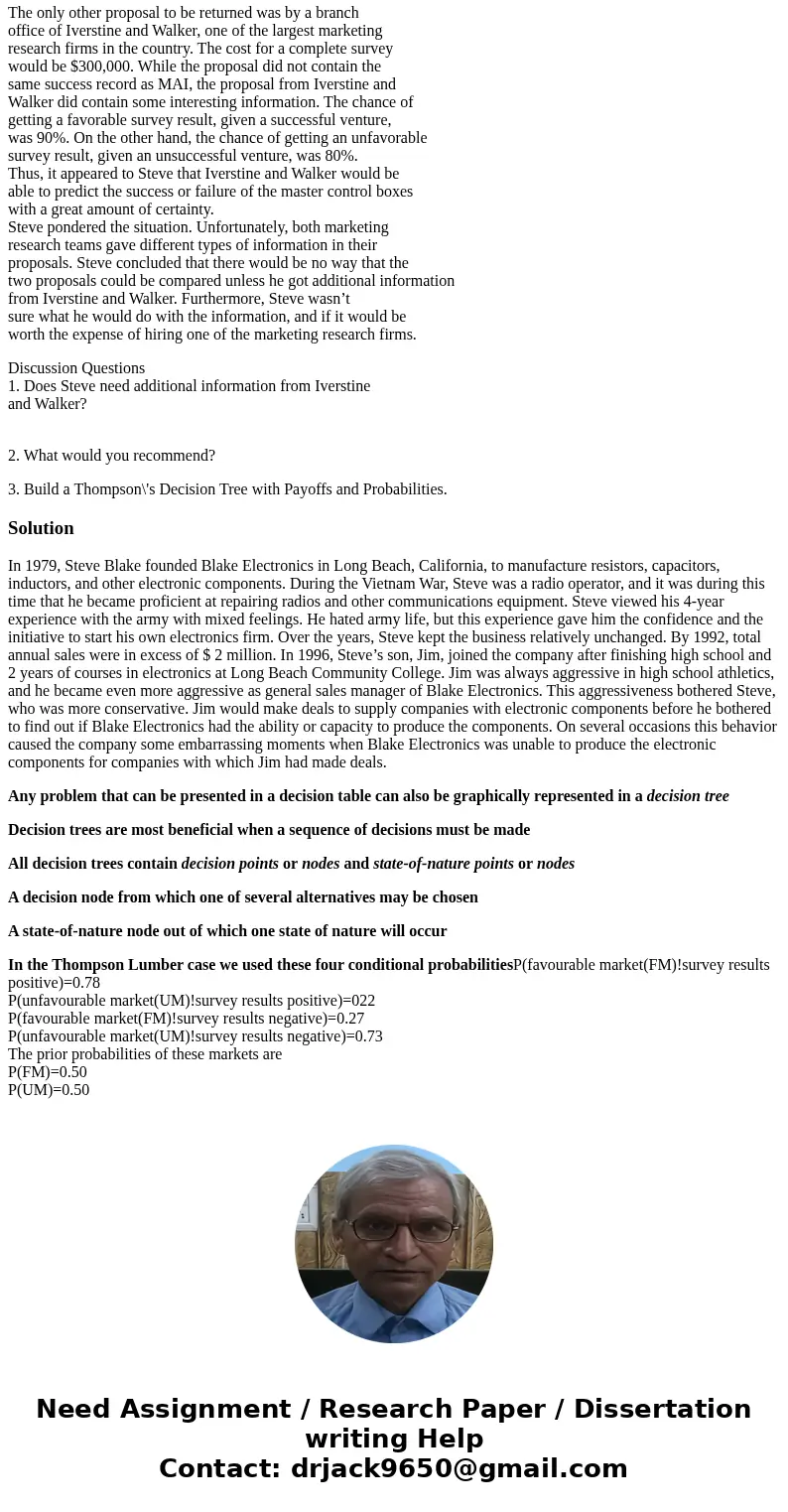In 1979 Steve Blake founded Blake Electronics in Long Beach
In 1979, Steve Blake founded Blake Electronics in Long
Beach, California, to manufacture resistors, capacitors, inductors,
and other electronic components. During the Vietnam
War, Steve was a radio operator, and it was during this time that
he became proficient at repairing radios and other communications
equipment. Steve viewed his four-year experience with
the army with mixed feelings. He hated army life, but this experience
gave him the confidence and the initiative to start his
own electronics firm.
Over the years, Steve kept the business relatively unchanged.
By 1992, total annual sales were in excess of $2 million. In 1996,
Steve’s son, Jim, joined the company after finishing high school
and two years of courses in electronics at Long Beach Community
College. Jim was always aggressive in high school athletics,
and he became even more aggressive as general sales manager of
Blake Electronics. This aggressiveness bothered Steve, who was
more conservative. Jim would make deals to supply companies
with electronic components before he bothered to find out if
Blake Electronics had the ability or capacity to produce the components.
On several occasions this behavior caused the company
some embarrassing moments when Blake Electronics was unable
to produce the electronic components for companies with which
Jim had made deals.
In 2000, Jim started to go after government contracts for
electronic components. By 2002, total annual sales had increased
to more than $10 million, and the number of employees
exceeded 200. Many of these employees were electronic specialists
and graduates of electrical engineering programs from
top colleges and universities. But Jim’s tendency to stretch
Blake Electronics to contracts continued as well, and by 2007,
Blake Electronics had a reputation with government agencies as
a company that could not deliver what it promised. Almost
overnight, government contracts stopped, and Blake Electronics
was left with an idle workforce and unused manufacturing
equipment. This high overhead started to melt away profits, and
in 2009, Blake Electronics was faced with the possibility of sustaining
a loss for the first time in its history.
In 2010, Steve decided to look at the possibility of manufacturing
electronic components for home use. Although this
was a totally new market for Blake Electronics, Steve was convinced
that this was the only way to keep Blake Electronics
from dipping into the red. The research team at Blake Electronics
was given the task of developing new electronic devices for
home use. The first idea from the research team was the Master
Control Center.
The heart of the system is the master control box. This unit,
which would have a retail price of $250, has two rows of five
buttons. Each button controls one light or appliance and can be
set as either a switch or a rheostat. When set as a switch, a light
finger touch on the button either turns a light or appliance on or
off. When set as a rheostat, a finger touching the button controls
the intensity of the light. Leaving your finger on the button
makes the light go through a complete cycle ranging from off to
bright and back to off again.
To allow for maximum flexibility, each master control box
is powered by two D-sized batteries that can last up to a year,
depending on usage. In addition, the research team has developed
three versions of the master control box—versions A, B,
and C. If a family wants to control more than 10 lights or appliances,
another master control box can be purchased.
The lightbulb disk, which would have a retail price of
$2.50, is controlled by the master control box and is used to
control the intensity of any light. A different disk is available
for each button position for all three master control boxes. By
inserting the lightbulb disk between the lightbulb and the
socket, the appropriate button on the master control box can
completely control the intensity of the light. If a standard light
switch is used, it must be on at all times for the master control
box to work.
One disadvantage of using a standard light switch is that
only the master control box can be used to control the particular
light. To avoid this problem, the research team developed a special
light switch adapter that would sell for $15. When this device
is installed, either the master control box or the light switch
adapter can be used to control the light.
When used to control appliances other than lights, the master
control box must be used in conjunction with one or more
outlet adapters. The adapters are plugged into a standard wall outlet,
and the appliance is then plugged into the adapter. Each outlet
adapter has a switch on top that allows the appliance to be controlled
from the master control box or the outlet adapter. The
price of each outlet adapter would be $25.
The research team estimated that it would cost $500,000
to develop the equipment and procedures needed to manufacture
the master control box and accessories. If successful, this
venture could increase sales by approximately $2 million. But
will the master control boxes be a successful venture? With a
60% chance of success estimated by the research team, Steve
had serious doubts about trying to market the master control
boxes even though he liked the basic idea. Because of his reservations,
Steve decided to send requests for proposals (RFPs)
for additional marketing research to 30 marketing research
companies in southern California.
The first RFP to come back was from a small company
called Marketing Associates, Inc. (MAI), which would charge
$100,000 for the survey. According to its proposal, MAI has
been in business for about three years and has conducted about
100 marketing research projects. MAI’s major strengths appeared
to be individual attention to each account, experienced
staff, and fast work. Steve was particularly interested in one part
of the proposal, which revealed MAI’s success record with previous
accounts. This is shown in Table 3.15.
The only other proposal to be returned was by a branch
office of Iverstine and Walker, one of the largest marketing
research firms in the country. The cost for a complete survey
would be $300,000. While the proposal did not contain the
same success record as MAI, the proposal from Iverstine and
Walker did contain some interesting information. The chance of
getting a favorable survey result, given a successful venture,
was 90%. On the other hand, the chance of getting an unfavorable
survey result, given an unsuccessful venture, was 80%.
Thus, it appeared to Steve that Iverstine and Walker would be
able to predict the success or failure of the master control boxes
with a great amount of certainty.
Steve pondered the situation. Unfortunately, both marketing
research teams gave different types of information in their
proposals. Steve concluded that there would be no way that the
two proposals could be compared unless he got additional information
from Iverstine and Walker. Furthermore, Steve wasn’t
sure what he would do with the information, and if it would be
worth the expense of hiring one of the marketing research firms.
Discussion Questions
1. Does Steve need additional information from Iverstine
and Walker?
2. What would you recommend?
3. Build a Thompson\'s Decision Tree with Payoffs and Probabilities.
Solution
In 1979, Steve Blake founded Blake Electronics in Long Beach, California, to manufacture resistors, capacitors, inductors, and other electronic components. During the Vietnam War, Steve was a radio operator, and it was during this time that he became proficient at repairing radios and other communications equipment. Steve viewed his 4-year experience with the army with mixed feelings. He hated army life, but this experience gave him the confidence and the initiative to start his own electronics firm. Over the years, Steve kept the business relatively unchanged. By 1992, total annual sales were in excess of $ 2 million. In 1996, Steve’s son, Jim, joined the company after finishing high school and 2 years of courses in electronics at Long Beach Community College. Jim was always aggressive in high school athletics, and he became even more aggressive as general sales manager of Blake Electronics. This aggressiveness bothered Steve, who was more conservative. Jim would make deals to supply companies with electronic components before he bothered to find out if Blake Electronics had the ability or capacity to produce the components. On several occasions this behavior caused the company some embarrassing moments when Blake Electronics was unable to produce the electronic components for companies with which Jim had made deals.
Any problem that can be presented in a decision table can also be graphically represented in a decision tree
Decision trees are most beneficial when a sequence of decisions must be made
All decision trees contain decision points or nodes and state-of-nature points or nodes
A decision node from which one of several alternatives may be chosen
A state-of-nature node out of which one state of nature will occur
In the Thompson Lumber case we used these four conditional probabilitiesP(favourable market(FM)!survey results positive)=0.78
P(unfavourable market(UM)!survey results positive)=022
P(favourable market(FM)!survey results negative)=0.27
P(unfavourable market(UM)!survey results negative)=0.73
The prior probabilities of these markets are
P(FM)=0.50
P(UM)=0.50



 Homework Sourse
Homework Sourse